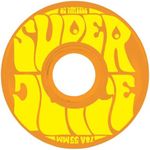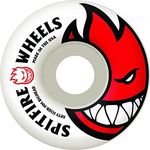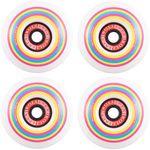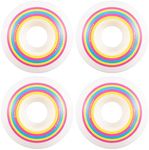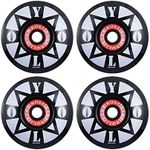Buying Guide for the Best Wheels For Skateboards
Choosing the right skateboard wheels is crucial for your skating experience. The wheels affect your speed, grip, and the overall feel of your ride. When selecting skateboard wheels, consider where you'll be skating, your skill level, and your personal preferences. Here are some key specifications to help you make an informed decision.DiameterThe diameter of skateboard wheels is measured in millimeters and typically ranges from 50mm to 75mm. Smaller wheels (50-54mm) are ideal for street skating and technical tricks because they offer better control and maneuverability. Medium-sized wheels (55-59mm) are versatile and suitable for both street and park skating. Larger wheels (60mm and above) are best for cruising and downhill skating as they provide more speed and a smoother ride. Choose the diameter based on your skating style and the terrain you'll be riding on.
DurometerDurometer measures the hardness of skateboard wheels, usually on a scale from 78A to 101A. Softer wheels (78A-87A) offer more grip and a smoother ride, making them ideal for cruising and rough surfaces. Medium hardness wheels (88A-95A) are versatile and suitable for both street and park skating. Harder wheels (96A-101A) provide less grip but more speed, making them perfect for smooth surfaces and technical tricks. Consider the type of skating you'll be doing and the surface you'll be riding on when choosing the durometer.
ShapeSkateboard wheels come in various shapes, including conical, radial, and square-edged. Conical wheels have a narrower profile and are lighter, making them great for technical tricks and street skating. Radial wheels have a rounded edge and offer a balance between grip and speed, suitable for all-around skating. Square-edged wheels provide maximum grip and stability, ideal for downhill and cruising. Your choice of wheel shape should depend on your skating style and the level of grip and stability you need.
Contact PatchThe contact patch is the area of the wheel that makes contact with the ground. A larger contact patch provides more grip and stability, which is beneficial for cruising and downhill skating. A smaller contact patch offers less grip but more speed and maneuverability, making it ideal for technical tricks and street skating. Consider the type of skating you'll be doing and the level of grip and stability you require when choosing the contact patch size.
Core PlacementCore placement refers to the position of the wheel's core, which can be centered, offset, or side-set. Centered cores provide a balanced ride and are suitable for all-around skating. Offset cores offer more grip and stability, making them ideal for cruising and downhill skating. Side-set cores provide less grip but more speed and maneuverability, perfect for technical tricks and street skating. Choose the core placement based on your skating style and the level of grip and stability you need.






